AI, particularly tools like ChatGPT, has demonstrated immense potential in streamlining various aspects of UX design. As designers face increasing demands for rapid iteration and user-centric solutions, leveraging AI tools can provide a competitive edge.
In this article, we'll dive into specific reasons to adopt ChatGPT in UX workflows, practical ways to integrate it, the best prompts to enhance your design tasks, and additional tools to further optimize your UX design process. Without further ado, let's uncover how AI can transform your approach to UX design.
First, why should you use ChatGPT for UX design? Actually, ChatGPT is like a personal assistant that UX designers can use. By integrating it into the workflow, designers can save both time and mental energy, making the entire process more agile and responsive to feedback.
For example, ChatGPT can quickly generate design ideas based on brief inputs, helping kickstart the brainstorming process. It can also craft concise and relevant UX microcopy, ensuring consistency in tone and messaging across the interface.
Furthermore, it can assist in synthesizing user research by summarizing key findings or even generating user personas based on research data. This allows teams to make informed decisions faster, ultimately leading to a more efficient design process and a product that better aligns with user needs.
Overall, ChatGPT minimizes the time spent on repetitive or tedious processes and allow designers to dedicate more energy to what truly matters— an exceptional user experiences.
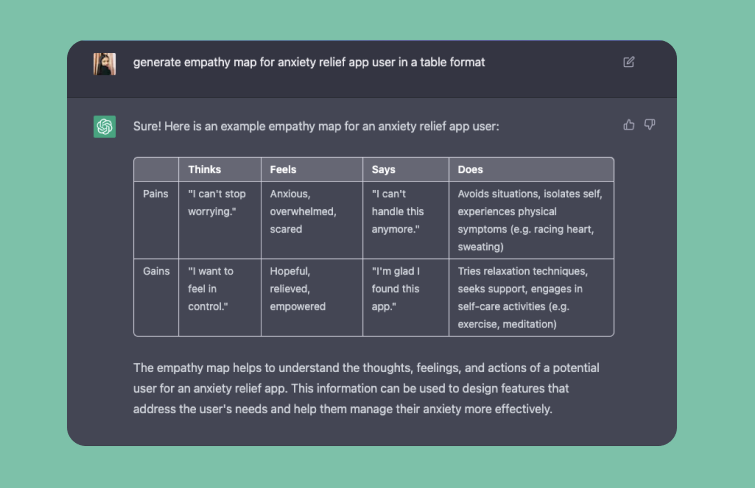
Before diving into specific ChatGPT prompts to streamline your UX design process in the following section, let's first explore the broader ways in which it can assist with UX design.
Market research is crucial for designing a product that meets user needs and fills a gap in the market. ChatGPT can assist by gathering insights and synthesizing information on industry trends, user preferences, and competitor analysis. Instead of manually searching through multiple resources, you can ask ChatGPT for a summary or even specific insights on market segments, product demand, or user behavior patterns. ChatGPT can also simulate user personas based on your target audience, helping you build more user-centric designs.
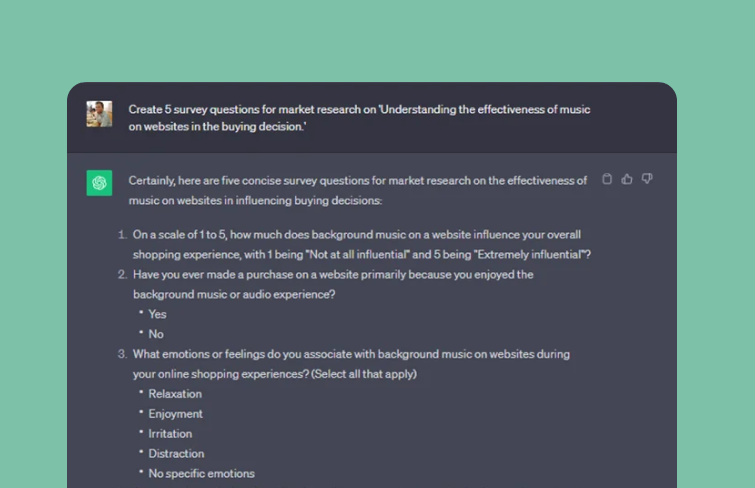
Designers often face creative blocks, and coming up with fresh, innovative ideas can be challenging. ChatGPT can help by generating design concepts, UI patterns, or suggestions for colors, typography, other design elements and even how to approach a specific design challenge.
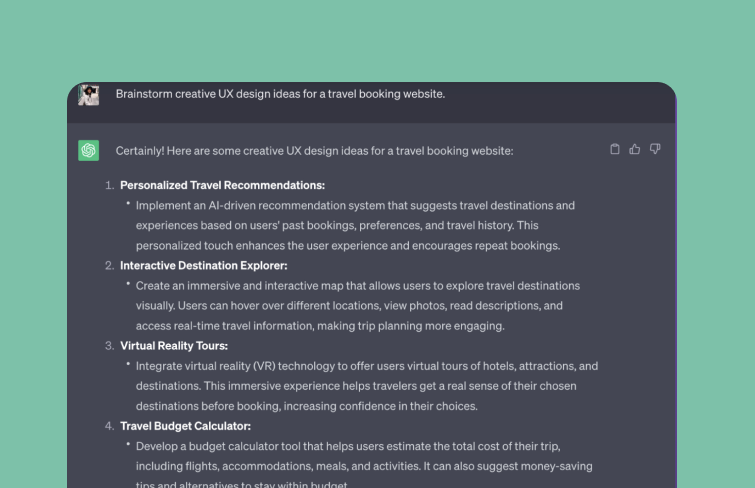
One of the most critical parts of UX design is creating clear, intuitive user flows that guide users through your product. ChatGPT can assist by generating user flow suggestions based on your design goals. You can ask it to outline the steps a user would take to achieve a specific task, such as signing up for a new service or making a purchase. This early-stage guidance ensures you design logical, friction-free paths for users, making the overall experience more enjoyable and effective.
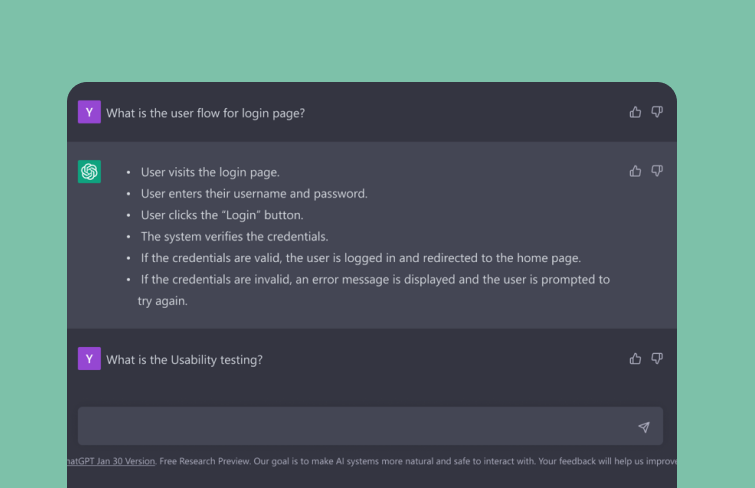
Wireframes serve as the blueprint for your design, but starting from scratch can sometimes feel overwhelming. ChatGPT can help by offering wireframe layout suggestions tailored to your specific needs. It can offers ideas for structuring different elements like navigation, content sections, buttons, and imagery.
While it won't replace the creative design process, ChatGPT offers a useful foundation that can inspire or guide your initial layouts, allowing you to focus on refining the details.
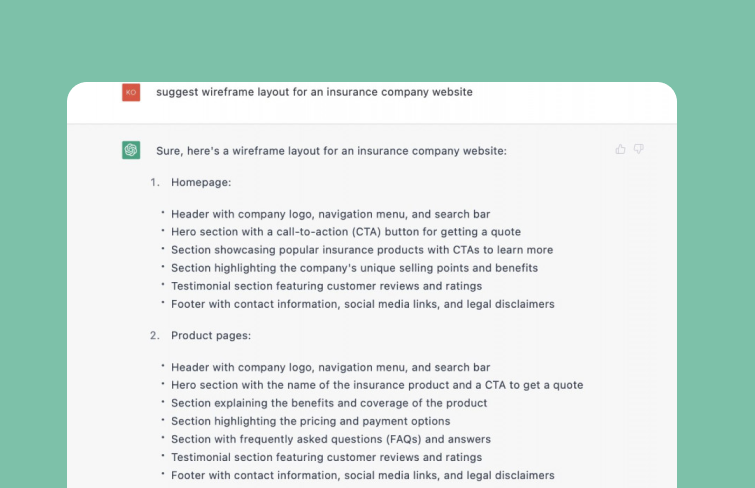
If you're looking to deepen your design expertise or explore new tools, ChatGPT can serve as an educational resource. You can ask for tutorials or recommendations for learning specific design tools such as Mockplus, Figma, Sketch, or Adobe XD. Beyond just tools, ChatGPT can also assist with learning broader design principles, guiding your growth as a designer while also providing tactical advice for immediate tasks.
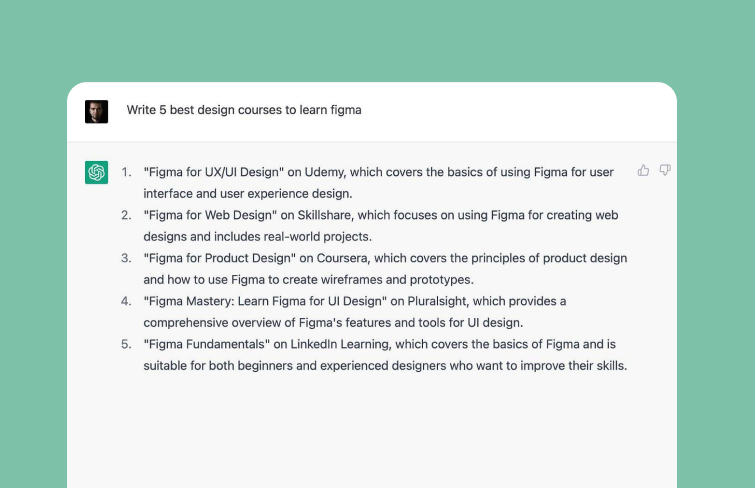
The effectiveness of ChatGPT in UX research heavily depends on how well you structure your questions. The way you frame your prompts can greatly influence the depth and relevance of the responses you get. To maximize ChatGPT's potential, it's essential to be clear and precise with your requests. Be sure to organize key information clearly, but keep your prompts concise and to the point.
Here are 30 ChatGPT prompts we handpicked for you to streamline your UX design process:
The first prompt we'll take a look at is for generating User Interview Questions. When using ChatGPT to create user interview questions, make sure to clarify the product, its target users, and specific research goals.
- Prompt example:
"Generate user interview questions for a [type of product] targeted at [target audience]. Focus on understanding [specific area, such as pain points, user behavior, or preferences]. Include both open-ended and follow-up questions."
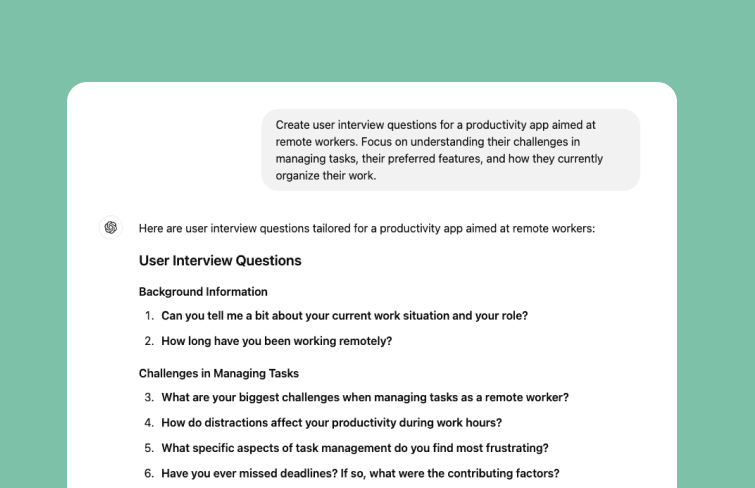
When generating user personas using ChatGPT, you should provide context about the product, target demographics, and user behavior.
- Prompt Example:
"Create a user persona for a [specific type of product] designed for [target audience]. Include details about their background, goals, challenges, and motivations."
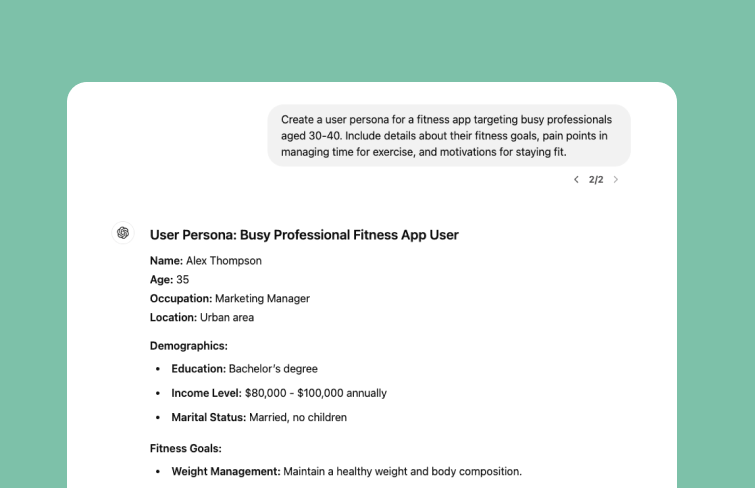
When using ChatGPT to explore user needs, be specific about the target audience and context to ensure relevant insights.
- Prompt Example:
"Explore the primary needs of users for a [type of product] targeted at [audience]. Focus on identifying desired outcomes, and key functionalities."
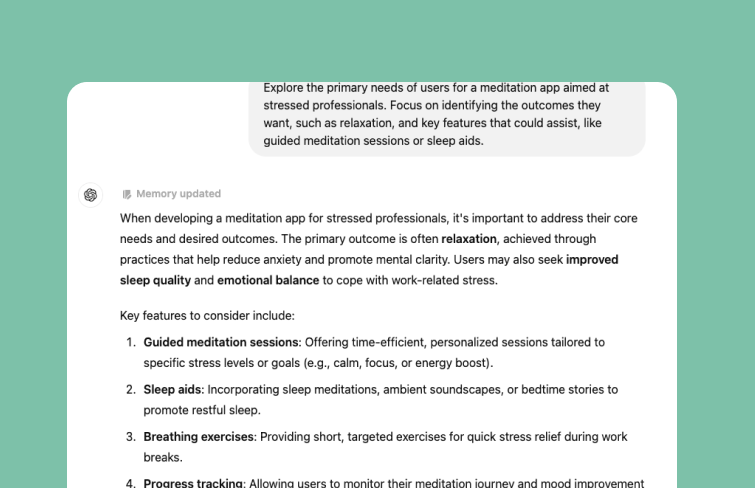
By providing sufficient context about the product and user group, designers can utilize ChatGPT to nderstand the specific frustrations and challenges users face when interacting with a product or service.
- Prompt example:
"What are the key pain points for [target audience] when using [type of product/service]?"
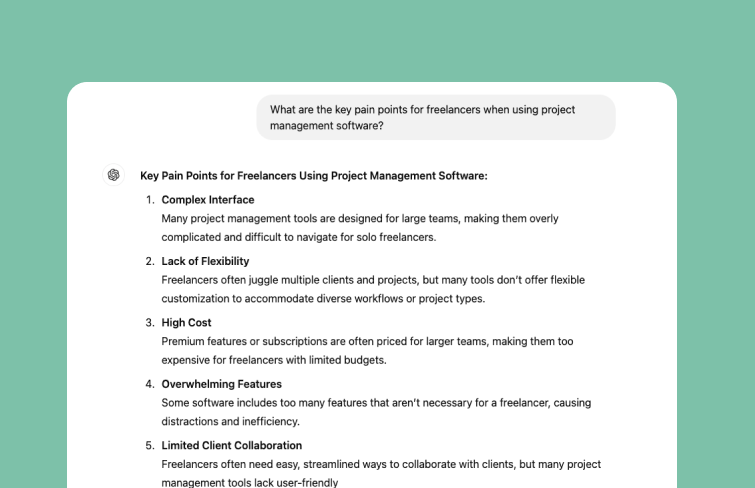
When using ChatGPT to extract actionable insights from user feedback, identify trends, preferences, and areas for improvement, be specific about the type of feedback, the product, and user demographic to ensure relevant analysis.
- Prompt example:
"Analyze the feedback provided by [target audience] about [product/service]. Identify common themes and areas for improvement."
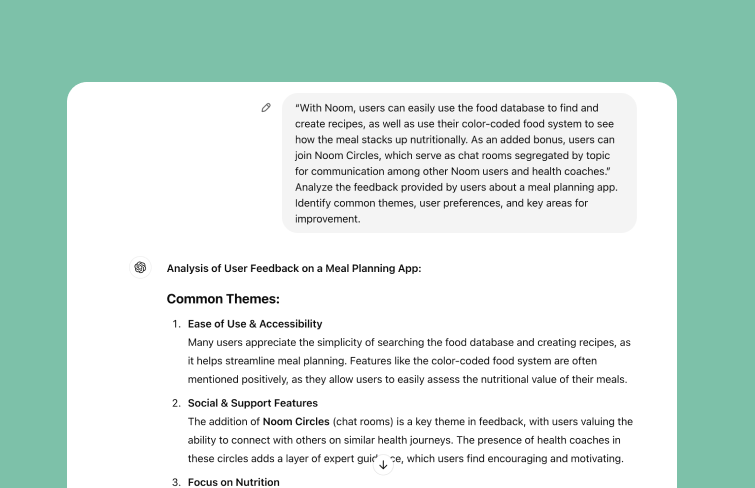
Designers can use ChatGPT to categorize users into distinct groups based on shared characteristics, behaviors, or preferences for targeted design and product development. Remember to provide details about the user base, such as demographics, usage patterns, and specific goals.
- Prompt example:
"Identify key user segments for [product/service] based on [demographic or behavioral criteria]. Highlight their unique characteristics and needs."
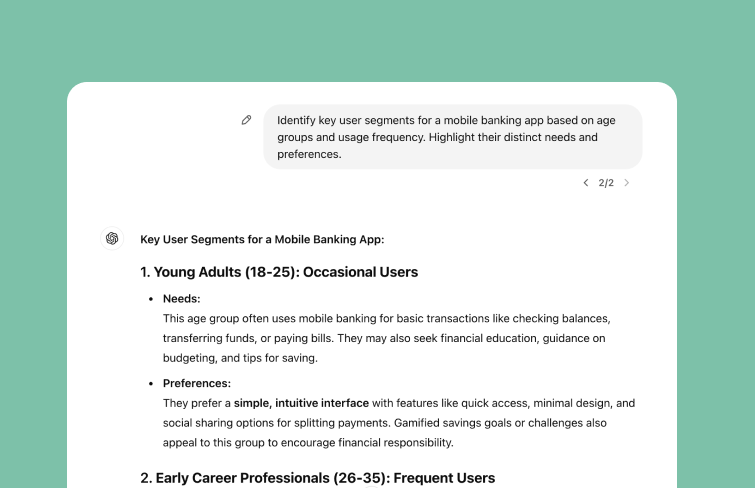
With ChatGPT, you can easily find frequent mistakes users make when interacting with a product by providing information about the product, typical user tasks, and where users often encounter difficulties.
- Prompt example:
"Identify common user errors in [product/service] during [specific task or feature]. Focus on mistakes that hinder user experience."
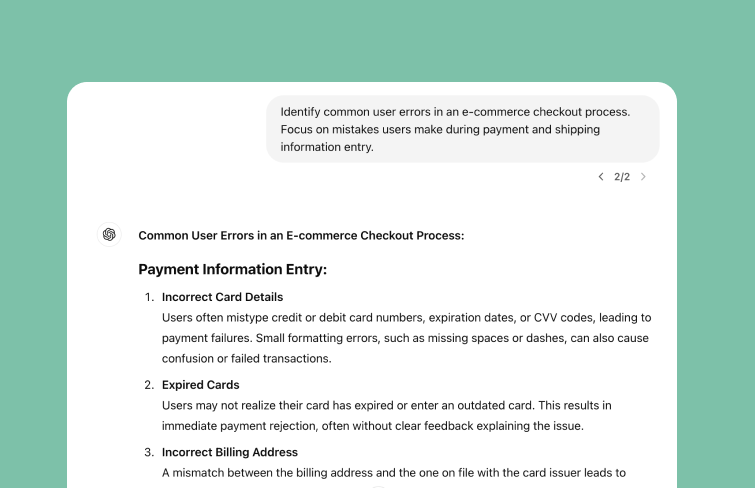
When using ChatGPT for generating user flows, make sure to provide with enough context about the product, its target users, and specific use cases.
- Prompt example:
"Create a user flow for [specific feature] of a [type of product] for [target audience]. Start from [entry point] and guide the user to [desired outcome]. Include key steps and decision points."
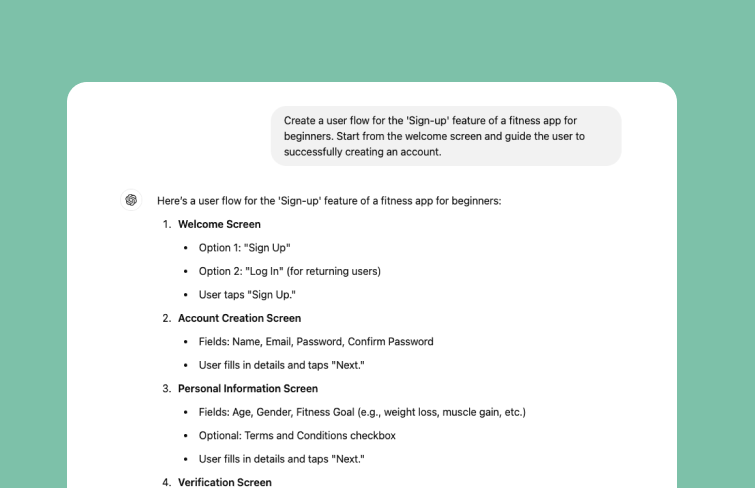
When developing user stories that help clarify user needs and expectations with ChatGPT, you should ensure
that you specify the type of product, the target user, and the user’s main goal for using the product.
- Prompt example:
"Write user stories for [specific product feature] that will help [target audience] achieve [desired outcome]."
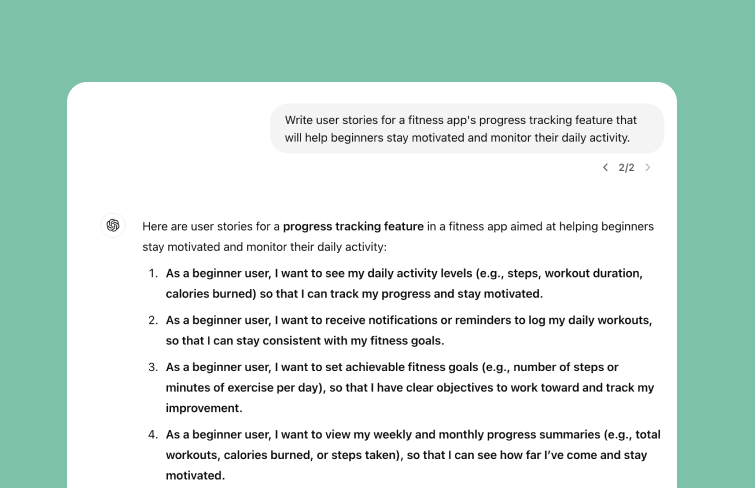
With ChatGPT, you can provide details about the type of product, its main content areas, and the target users to guide the organization effectively to create a clear structure for organizing content within a product.
- Prompt example:
"Outline the information architecture for a [type of product] that includes [main content areas] for [target audience]."
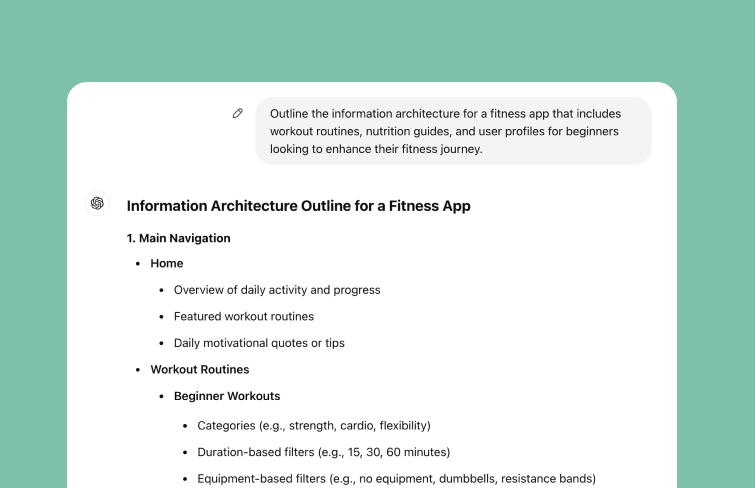
When generating innovative and functional wireframe layout ideas, specify the type of product, its key features, and the target audience to ensure the wireframes address user needs effectively.
- Prompt example:
"Ideate wireframe layouts for a [type of product] featuring [key features] aimed at [target audience]."
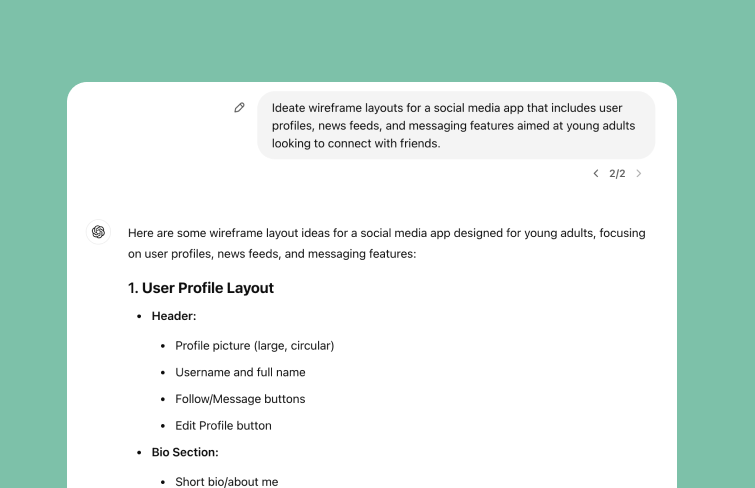
Clearly define the type of product, its primary goals, and the target audience to generate a diverse range of innovative feature ideas that enhance the functionality and appeal of a product.
- Prompt example:
"Brainstorm features ideas for a [type of product] aimed at [target audience] that focus on [specific goals or functionalities]."
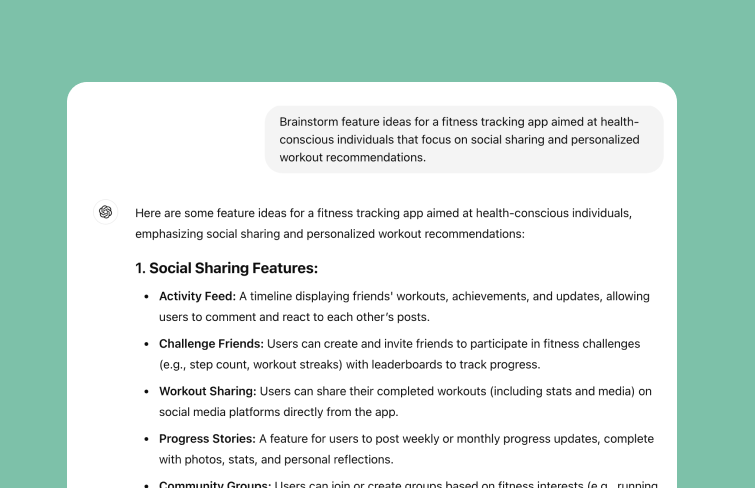
To generate suggestions for enhancing an existing product's features, usability, and overall user experience, you should provide context about the product, current user feedback, and specific areas of improvement to yield targeted and practical suggestions.
- Prompt example:
"Ideate product improvements for a [type of product] based on [specific user feedback or issues]."
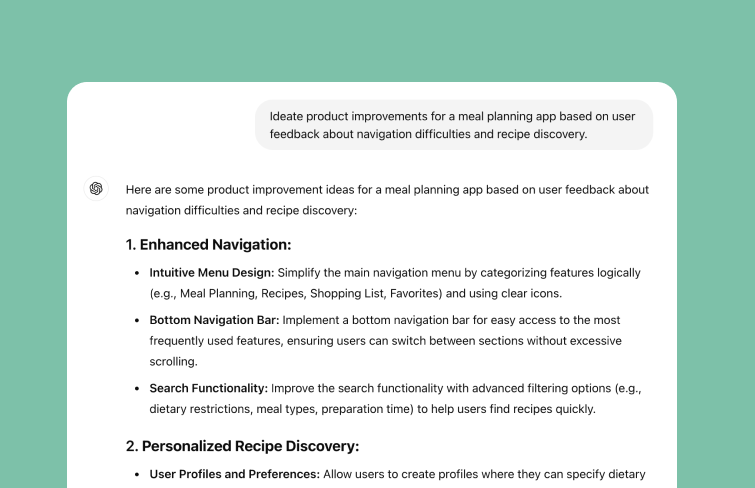
Clearly describe the product, its current features, and any specific goals or user needs that should be addressed in the new features.
- Prompt example:
"Suggest new features for a [type of product] that would improve [specific aspects or user experiences]."

Provide context about the type of product, its target audience, and the specific goals or challenges the design patterns should address to identify effective interaction design patterns that can improve user experience and usability for a specific product.
- Prompt example:
"Suggest interaction design patterns for a [type of product] aimed at [target audience] that will enhance [specific user interactions or experiences]."
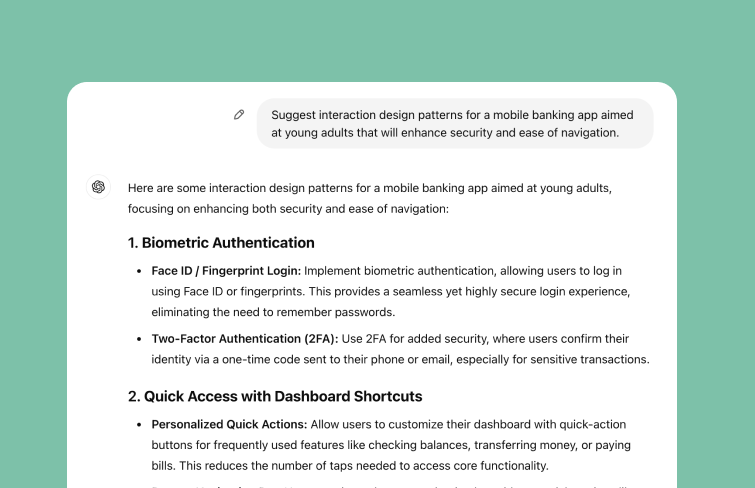
Subtle, engaging microinteractions can improve user experience by providing immediate feedback, guiding behavior, or making interactions feel more intuitive. When using ChatGPT to suggest microinteractions, you should describe the product type and the specific touchpoints where microinteractions could enhance usability or enjoyment.
- Prompt example:
"Suggest microinteractions for a [type of product] that enhance [specific user interaction or experience]. Focus on key touchpoints like [touchpoint] and [touchpoint]."
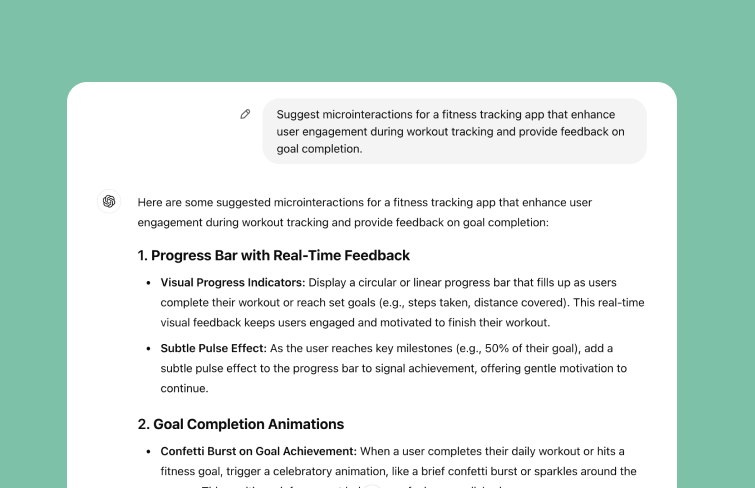
You can use ChatGPT to suggest a color scheme that aligns with the product's type, brand identity, and the mood or emotion you want to convey. Be sure to provide clear details about the product, brand personality, and the desired feeling you want users to experience.
- Prompt Example:
"Suggest a color scheme for a [specific type of product] that reflects [desired mood or brand identity]. Include primary, secondary, and accent colors."

You can use ChatGPT to create clear and effective typography recommendations that ensure readability, brand consistency, and a balanced visual hierarchy. Do consider the product type, target audience, and overall tone or brand identity when suggesting typography.
- Prompt example:
"Suggest typography guidelines for a [type of product] that reflect [desired mood or brand identity]. Include font styles, sizes, and usage recommendations for headers, body text, and call-to-actions."

ChatGPT can provide recommendations for tools that allow designers to quickly create and test prototypes to validate ideas or design concepts. Take into account the factors such as designer's proficiency, the desired prototype fidelity (low or high), and the need for collaboration features.
- Prompt example:
"Recommend tools for rapid prototyping a [specific type of product] targeting [specific user base]. Include tools for both wireframing and interactive prototyping."
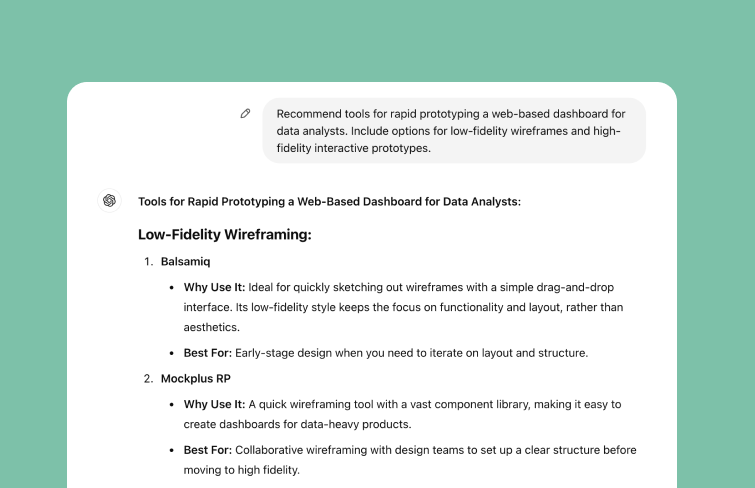
ChatGPT can also enhance UX design process by offering a set of strategies to help guide content creation that resonates with the target audience, aligns with business goals, and promotes engagement.
- Prompt example:
"Suggest content strategies for a [specific type of product] targeted at [specific audience] to increase engagement and drive conversions."
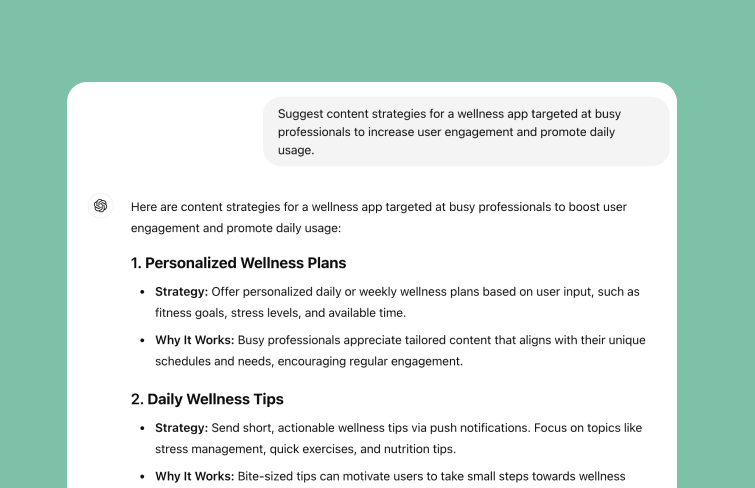
Use ChatGPT to get a list of best practices for creating intuitive, user-friendly designs that enhance usability and meet user expectations.
- Prompt example:
"Suggest best practices for designing a [specific type of product] for [specific audience], ensuring usability and accessibility."
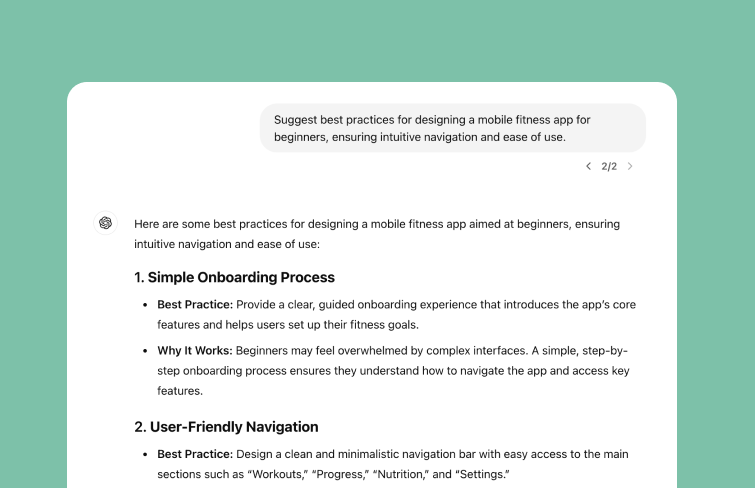
When use ChatGPT to analyze and identify current trends in a particular industry to stay ahead of the competition and adapt your design strategy accordingly, you should be sure to specify the industry and the timeframe you are interested in.
- Prompt example:
"Identify the latest trends in [specific industry] over the past [specific time frame], focusing on design, user behavior, and technology adoption."
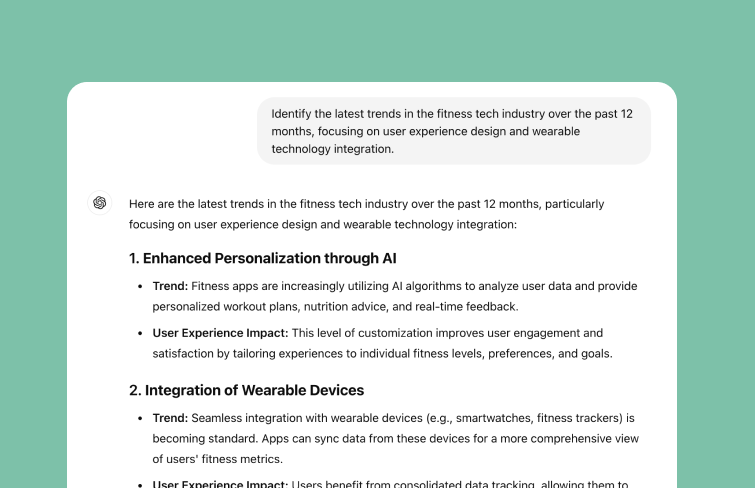
ChatGPT can create concise summaries of lengthy texts, reports, or articles to extract key points and insights, making the UX design process more efficient. Provide the specific text or main ideas you want summarized, along with any focus areas you want to emphasize.
- Prompt example:
"Summarize the main points of [specific text or article], highlighting key findings and conclusions."
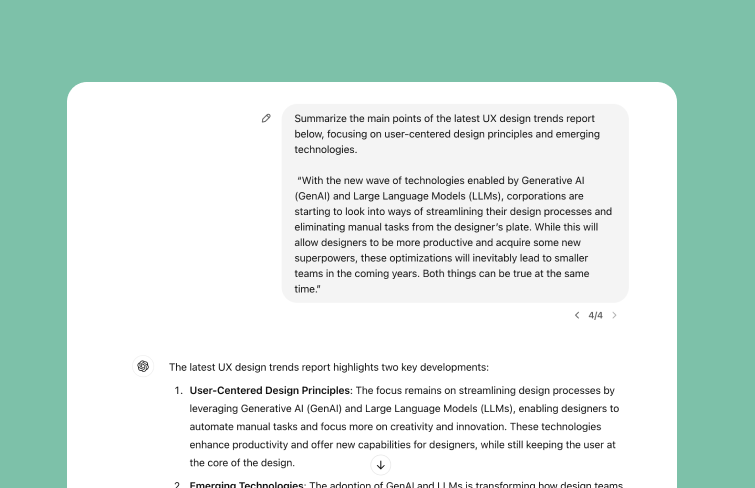
When using ChatGPT to generate a competitor analysis, provide details about the product, the market, and the specific aspects you want to compare, such as features, pricing, and user experience.
- Prompt Example:
"Conduct a competitor analysis for [specific type of product] in the [industry/market]. Compare [specific aspects like features, pricing, strengths, and weaknesses] of the top three competitors."
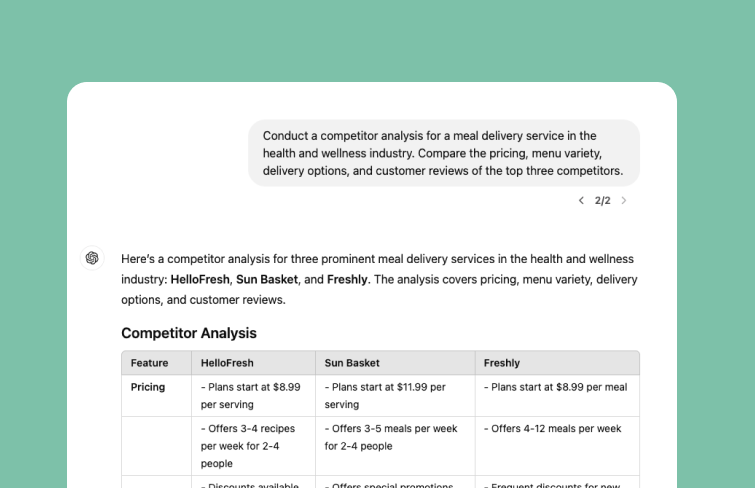
By pinpoint the most essential features for a Minimum Viable Product (MVP) can ensure that the core functionalities needed for the product’s success are included. To get relevant suggestions, you should clearly define the product, its target users, and the core problem it solves
- Prompt example:
"Identify the key features for the MVP of a [type of product] designed for [target audience]. Focus on the core functionalities that solve [specific problem]."
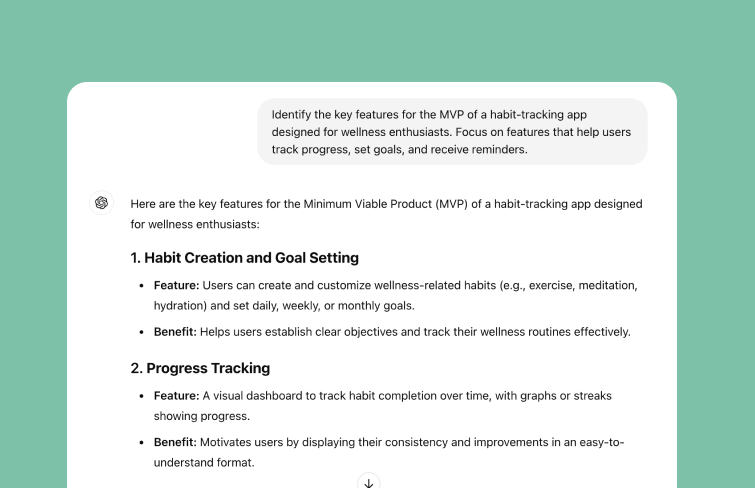
With ChatGPT, you can create detailed and actionable checklists for specific tasks or processes, ensuring that all necessary steps are covered.
- Prompt example:
"I'm designing a [specific element] for [type of product]. Create a checklist of what I should consider including."
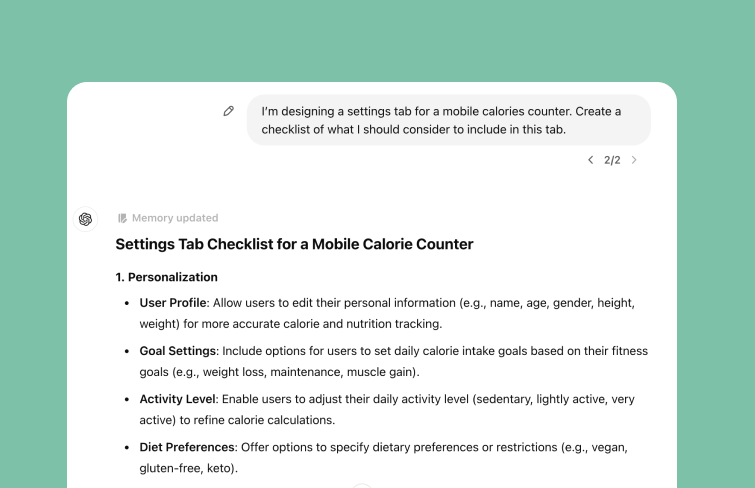
Use ChatGPT to create placeholders for specific content sections, such as text, images, or media within a design or development project.
- Prompt example:
"I'm designing a [specific element] for a [type of product]. Generate placeholders for [content type] in the [specific section]."
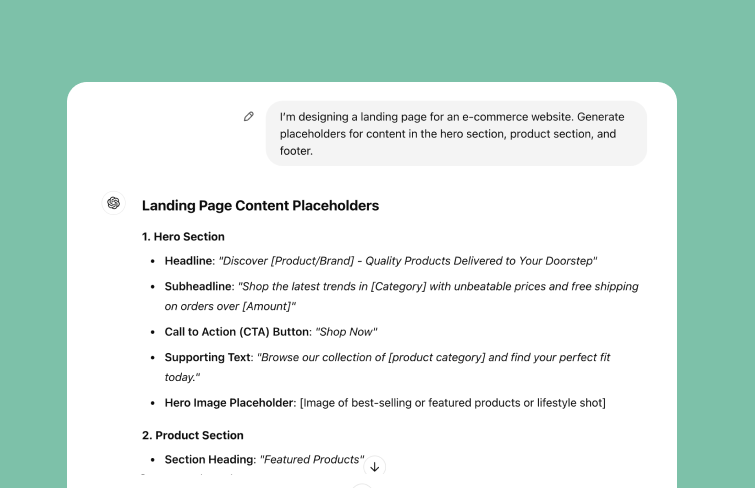
ChatGPT can also work as a efficient translator. You can use ChatGPT to quickly translate text from one language to another while maintaining accuracy and context.
- Prompt example:
"Translate the following [source language] text into [target language]: [insert text]."
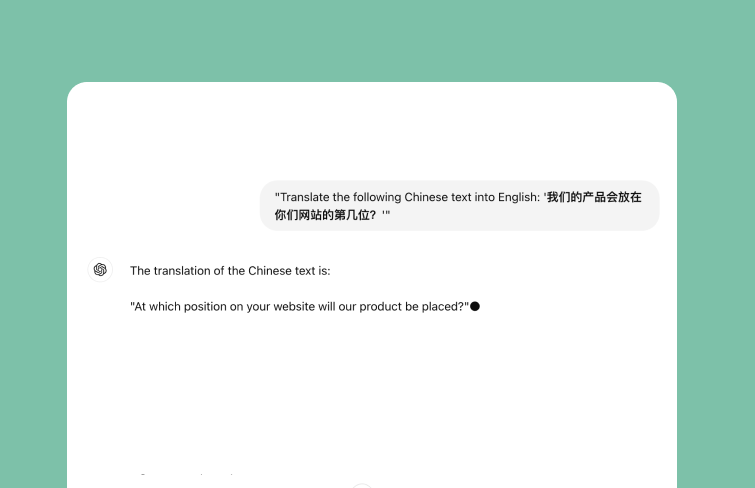
You can also provide context about the product or service and the target audience to discover the emotional triggers that can influence user behavior and enhance user experience.
- Prompt example:
"Identify key emotional triggers for [type of product or service] targeting [target audience]."
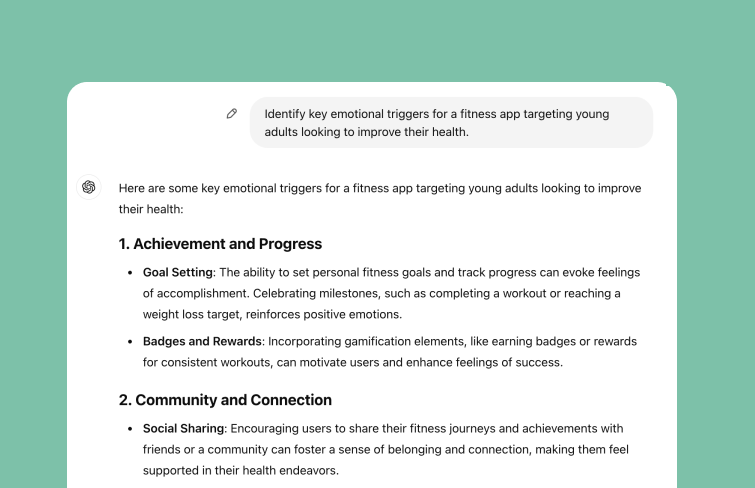
ChatGPT can also guide you through the basic functions and advanced features of specific design tools. Be sure to specify the design tool you want to learn and the specific features or workflows you are interested in.
- Prompt example:
"Teach me how to use [design tool], focusing on [specific feature or workflow]."
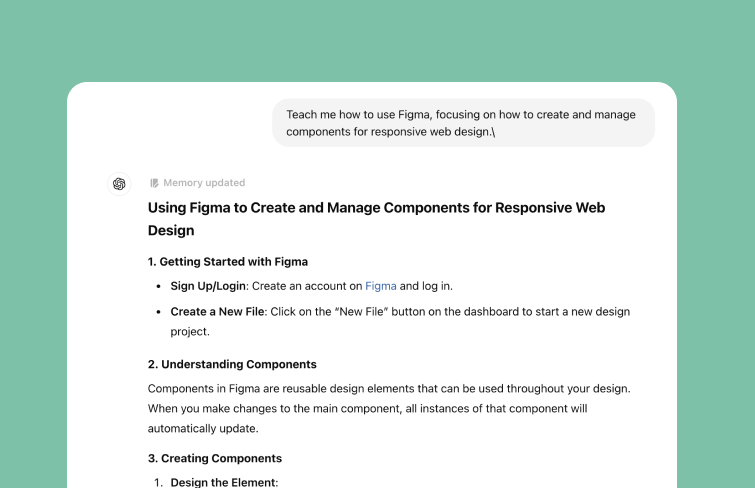
Here are several other platforms and tools that can further enhance your UX design workflow:
Mockplus RP is an online prototyping tool that simplifies the process of creating interactive prototypes and UI/UX flowcharts. With its ready-made shapes, components, and other design elements, you can quickly design user flows for onboarding, login, and other interactions using a simple drag-and-drop interface. Mockplus also lets you easily connect shapes with wires to showcase flow and logic. Moreover, with its powerful interactive and animation features, you can simulate real user experiences to create a seamless user journey.
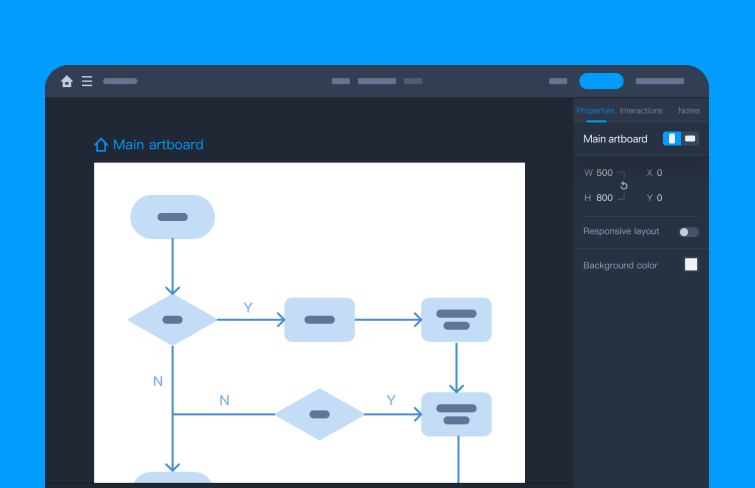
Balsamiq is a user-friendly tool made for quick wireframing and prototyping, offering a highly intuitive tool for UX designers to rapidly visualize ideas. Its ease of use encourages collaboration among teams, allowing them to quickly sketch out interface concepts for websites or apps, facilitating early-stage design discussions and user experience brainstorming sessions.
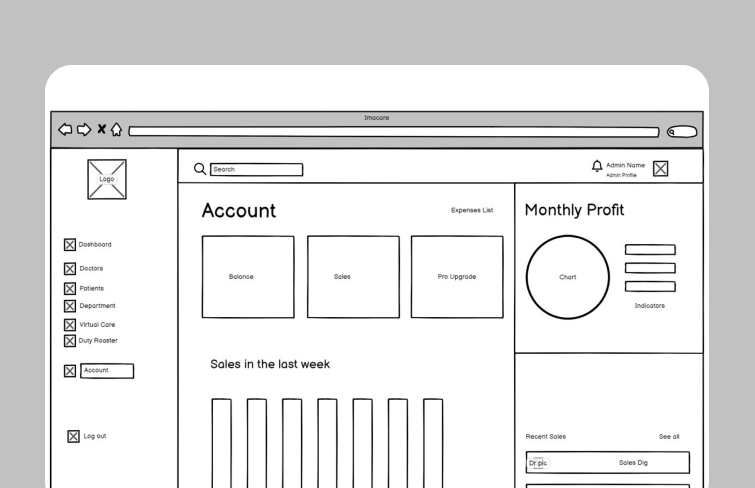
UXCam is a robust tool designed for managing app performance, enabling teams to dive deep into user experience optimization. Beyond basic metrics, it provides qualitative insights, helping product teams and developers understand the reasons behind user actions. This makes it invaluable for continuously tracking behavior, identifying pain points, and refining app interactions for a better user experience.
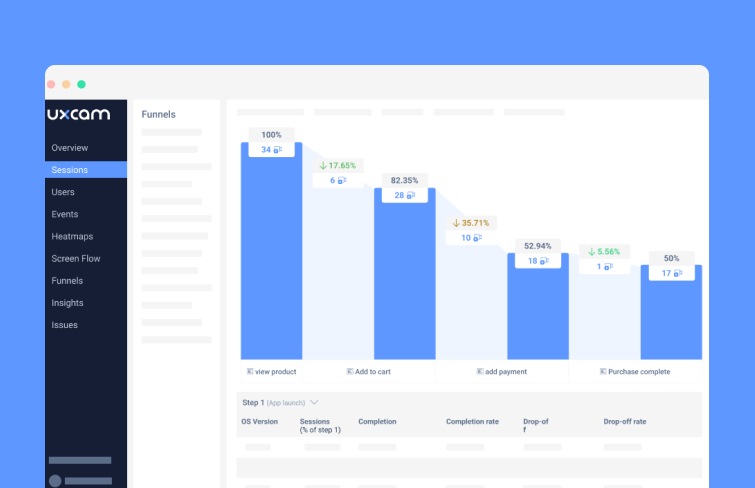
Figma is an online UI design tool. It also comes with powerful features for whitboarding and diagramming, offering a virtual space for brainstorming, teams to sketch out ideas, leave notes, and engage in real-time discussions. Its extensive templates simplify the process of mapping user journeys & user flow. Designers can quickly visualize and plan how users will interact with a product, ensuring a seamless experience.

In conclusion, ChatGPT is undeniably a powerful asset for UX design, providing both efficiency and creative assistance at various stages of the UX design process. To fully harness its potential, creating precise and well-structured prompts is essential. When you clearly define your objectives and provide the necessary context, you'll notice how ChatGPT can truly streamline your work.
 Mockplus RP
Mockplus RP
A free prototyping tool to create wireframes or interactive prototypes in minutes.
 Mockplus DT
Mockplus DT
A free UI design tool to design, animate, collaborate and handoff right in the browser.
